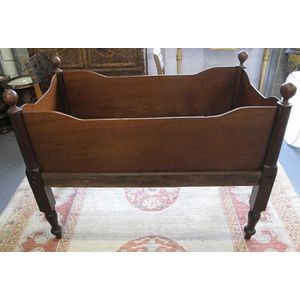George III Carved Oak Settle with Medieval Carvings
You must be a subscriber, and be logged in to view price and dealer details.
Subscribe Now to view actual auction price for this item
When you subscribe, you have the option of setting the currency in which to display prices to $Au, $US, $NZ or Stg.
- Grotesque - Grotesque decoration is any fanciful ornament applied to furniture and decorative arts, and includes distorted faces, mythical animals such as satyrs and sphinxes and less frequently fantastical fruit and flower forms.
The Martin Brothers who set up their pottery at the end of the nineteenth century in Southall, Middlesex derived their fame from their hand made models of grotesque stoneware birds. - George Iii - George III (1738 - 1820) was King of Great Britain and Ireland from 1760 to 1820.
- Panels - Timber pieces, usually of well-figured wood either recessed or applied over the frames of doors and as decoration elsewhere in the carcase of cabinet furniture. The panels may take a variety of shapes rectangular, square, shield shape, oval, half-round or in the form of Egyptian pylons.
- Oak - Native to Europe and England, oak has been used for joinery, furniture and building since the beginning of the medieval civilisation. It is a pale yellow in colour when freshly cut and darkens with age to a mid brown colour.
Oak as a furniture timber was superceded by walnut in the 17th century, and in the 18th century by mahogany,
Semi-fossilised bog oak is black in colour, and is found in peat bogs where the trees have fallen and been preserved from decay by the bog. It is used for jewellery and small carved trinkets.
Pollard oak is taken from an oak that has been regularly pollarded, that is the upper branches have been removed at the top of the trunk, result that new branches would appear, and over time the top would become ball-like. . When harvested and sawn, the timber displays a continuous surface of knotty circles. The timber was scarce and expensive and was used in more expensive pieces of furniture in the Regency and Victorian periods.
This item has been included into following indexes:
Visually similar items

A George II oak settle c.1740 - 1750 and later, having four panel back with arm rests and cabriole front legs height 108 cm, length 181 cm, depth 60 cm

Australian Colonial cedar and blackwood cot circa 1840, measures 67 x 120 x 93 cm high

An Australian Arts & Crafts settee, influenced by Frank Lloyd Wright, circa 1905. 85 cm high, 137 cm wide and 58 cm deep

A set of eight Louis XIII style leather and oak chairs, late 19th to early 20th century, the square back chairs with shell form finials, leather back rests embossed with a trailing vine and grape motif above a series of spindles to the mid-rail, the side s
